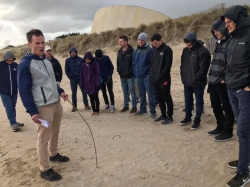Reliving D-Day
PROVO, Utah – Jun 26, 2019 – Standing on Utah Beach, each senior cadet told the story of a soldier or civilian involved in the Allied invasion of Normandy during World War II. Cadets told these stories in the first person while looking at the battlefield on which American soldiers fought for the liberation of France seventy-five years ago.
This year’s staff ride to France gave senior cadets in the BYU Army ROTC program an intimate understanding of the events that occurred on D-Day and a deeper appreciation for the sacrifices of their military predecessors. Staff rides are conducted each year and involve a trip to the site of a major engagement in American military history as well as an intense analysis of the conflict. Previous staff rides have been to Gettysburg, Pennsylvania, and Little Big Horn, Montana, of George Custer fame.
“The purpose of these trips is to understand the scope of leadership positions within the military,” says LTC Forrest “Chip” Cook, a military-science professor with the ROTC program. “The actions of a leader affect everyone in their command, including civilians, in situations like this. It’s important that the cadets give their reports in first person because it makes the experience that much more personal to everyone involved.”
Cadet Ashton Winslow, an economics major from Highlands Ranch, Colorado, studied the fighter aircraft and bombers involved in the Normandy landings. “Through my study, I found that every piece of the operation was necessary for success,” says Winslow. “I left France with a greater sense of the tradition that I am a part of. I will serve in the same Army and defend the same values as those soldiers who died in Normandy, France.”
Normandy stands out from other staff ride experiences Cook has been involved with over the years. “It's probably the most prominent effort the US military has ever engaged in,” Cook says. “And so, to be on the ground and to see it firsthand and understand the scope of the assault is humbling.”
Senior cadet Tyler Meidell, an accounting major from Reno, Nevada, researched Major Dick Winters, a young paratroop company commander who served throughout Europe, even after the formal end of the war. “I learned to see Maj. Winters as a human instead of a superhero,” says Meidell. “The foundation of his leadership in combat taught me to prepare now to be as tactically proficient as I can while I prepare to enter the Infantry Basic Officer Leadership Course.”
The reality of standing on the beach where so many of their military predecessors gave their lives caused the cadets to reflect on what it means to sacrifice. “During my experience on the beach, I wanted to talk with all the fallen soldiers collectively to learn if they felt their sacrifice was worth the high price they had to pay,” says Meidell.
As part of the staff ride, the cadets also visited cemeteries for American, British, and German soldiers who died in the conflict. “Kneeling in that cemetery, I gained a powerful understanding of what military service is about,” says cadet Aaron Hansen, a Spanish major from Nampa, Idaho. “Military service is about self-sacrifice, commitment to the Army values, and being willing to complete the tasks that our nation’s democratically elected leaders deem necessary.”
Media Contact: Chad Little (801) 422-1512
Writer: Ellen Ford




